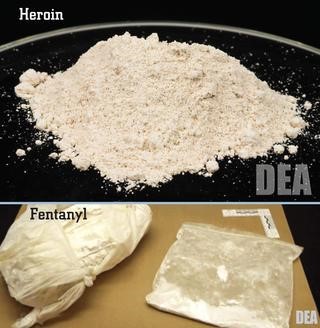Fentanyl
 What are the street names/slang terms for fentanyl?
What are the street names/slang terms for fentanyl?
Apace, China Girl, China Town, China White, Dance Fever, Goodfellas, Great Bear, He-Man, Poison and Tango & Cash
What is fentanyl?
Fentanyl is a powerful synthetic opioid 80 to 100 times more potent than morphine that is used to treat patients with severe pain or to manage pain after surgery. It is also sometimes used to treat patients with chronic pain who are physically tolerant to other opioids.
What does fentanyl look like?
Fentanyl is available as a pill, powder, blotter paper, tablet, spray or under-the-tongue film. Time-release formulas of fentanyl come in gel patches or lollipops. Injectable forms are found in hospital settings. The street-produced version of fentanyl is typically in powder form.
How is it used?
In its prescription form, fentanyl is known as Actiq, Duragesic and Sublimaze. When prescribed by a physician, fentanyl is often administered via injection, transdermal patch or in lozenges. However, the fentanyl and fentanyl analogs associated with recent overdoses are produced in laboratories and sold in the following forms: as a powder, spiked on blotter paper, mixed with or substituted for heroin, or as tablets that mimic other less potent opioids. People can swallow, snort or inject fentanyl, or they can put blotter paper in their mouths so that fentanyl is absorbed through the mucous membrane. In many cases, people unknowingly take fentanyl when mixed with other drugs like heroin or cocaine or as counterfeit prescription pills.
What are its effects?
Like heroin, morphine and other opioid drugs, fentanyl works by binding to the body's opioid receptors, which are found in areas of the brain that control pain and emotions. When opioid drugs bind to these receptors, they can drive up dopamine levels in the brain’s reward areas, producing a state of euphoria and relaxation. Fentanyl’s effects resemble those of heroin and include euphoria, drowsiness, nausea, confusion, constipation, sedation, tolerance, addiction, respiratory depression and arrest, unconsciousness, coma and death.
What is its federal classification?
Schedule II
Source
National Institute on Drug Abuse (NIDA); Drug Enforcement Administration (DEA)